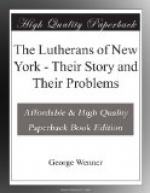Henry Melchior Muehlenberg came to America from Halle in 1742 to minister to the congregations in and near Philadelphia. The disordered condition of the American churches opened a wide field for his administrative ability, and for the rest of his life, in addition to his pastoral activity, he accomplished a great task in the planting and organization of churches. He is rightly called the Patriarch of the Lutheran Church in America.
In response to an urgent appeal, Muehlenberg came over from Pennsylvania in 1751 and assumed the pastorate of Trinity church. Although he spent but a short time in 1751 and again in 1752 on the ground, he was for two years pastor of the mother church. His was a fruitful ministry. He succeeded to a considerable extent in reconciling the warring elements in the congregation, not only by his gifts as a preacher and spiritual leader, but also by his ability to preach in Dutch and in English as well as in German.
The Episcopalians, who worshipped in the Trinity Church on the opposite corner, complained of the stentorian tones in which he delivered his sermons.
Upon Muehlenberg’s recommendation, Mr. Weygand of Raritan, was chosen pastor of Trinity Church in 1753. In the furtherance of his ministry, Weygand performed some literary work. He prepared an English translation of the Augsburg Confession, which was printed as a supplement to a quarto volume of 414 pages published by one of the elders of his church, entitled “The Articles of Faith of the Holy Evangelical Church According to the Word of God and the Augsburg Confession. A Translation from the Danish. New York, MDCCLIV.”
The congregation continued to be Dutch, although Weygand preached also in German and in English as occasion required. For the use of his English congregations he published in 1756 a translation of German hymns that had appeared in England under the title, “Psalmodia Germanica.”
From 1750 to the time of the American Revolution we had two Lutheran churches in New York, the German Christ church, popularly known as “The Old Swamp Church,” on Frankfort Street, and the Dutch Trinity church on Broadway and Rector Street.
In the Swamp church the first preacher, Ries, remained for a year. He was followed in quick succession by Rapp, Wiessner, Schaeffer, Kurz, Bager and Gerock. Only the last named served long enough to identify himself with local history. He was followed by Frederick Muehlenberg, a son of Henry Melchior, an ardent patriot, who had expressed himself so freely in regard to English rule that when the British army marched into New York in 1776 he found it expedient to retire as quickly as possible to Pennsylvania. Here he labored in several congregations; as supply or as pastor, until 1779, when the exigencies of the times compelled him to take an active part in the political affairs of the country.
[illustration: “The Old Swamp Church”]
The partial reconciliation that had been brought about by Muehlenberg between the Dutch and the German congregations was occasionally disturbed by a pamphletary warfare conducted by their respective pastors, Weygand and Gerock.




